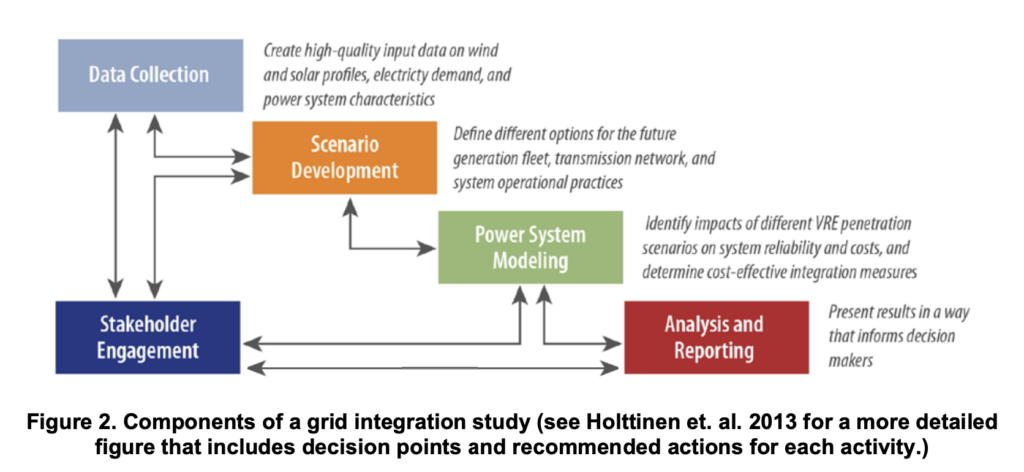Deep, collaborative engagement with power sector stakeholders is one of the most important aspects of a successful grid integration study. Strong stakeholder engagement ensures that the grid integration study is ground-truthed, addresses the concerns of all interested stakeholders, and provides insights that decision makers can act on.
Main Points
- Prioritizing collaboration with stakeholders is one of the most fundamental elements of a successful grid integration study—from start to finish.
- Two common stakeholder engagement processes are a study’s Modeling Working Group and Technical Review Committee, each of which plays an important role.
- Identifying the right power sector stakeholders to engage in your study is a crucial first step.
First, Read This
Decisions about the power system impact a great diversity of stakeholders, from power project developers to consumers. A good grid integration study will include the perspectives of as many of these communities as possible.
A grid integration study that engages a broad array of stakeholders contributes to relevant, robust, and actionable planning that reflects industry and policymaker concerns. Stakeholder engagement helps to ensure study assumptions are grounded in reality and results have enough credibility to guide power sector transformation. Stakeholders come from across the electric power sector. Since many stakeholders will be involved in developing and implementing grid integration measures, involving these groups in as many phases of a grid integration study as possible helps to ensure the results are relevant to these diverse perspectives. Examples of important stakeholders in integration studies include:
Text excerpt from page 10 of Variable Renewable Energy Grid Integration Studies: A Guidebook for Practitioners by NREL
- National or subnational government energy agencies
- Power system operators (such as regional transmission organizations, independent system operators, and/or vertically integrated utilities, among others)
- Electricity regulators
- Electricity market operators (where applicable)
- Utilities (if distinct from the system operator)
- Transmission providers and developers
- Wind and solar data providers
- Conventional and RE plant owners, operators, and developers
- Researchers and academia
- Public advocates
Now, Look at This
Collaboration and dialogue with stakeholders should be a priority at every stage of your grid integration study.

See: Figure 2 from page 10 of Variable Renewable Energy Grid Integration Studies: A Guidebook for Practitioners by NREL.
Next, Read About Common Stakeholder Engagement Processes
Technical Review Committee
Your Technical Review Committee provides outside expertise and input at important decision points throughout the grid integration study. They comment on the study’s scope, the work of the Modeling Working Group, and more, ensuring that a diversity of industry, regulatory, policymaking, and impartial expert perspectives is represented in the study and making it easier for decision makers to act on the study’s findings with confidence.
A Technical Review Committee, also referred to as a technical advisory committee (TAC), facilitates productive engagement in a grid integration study. The members of a TRC provide rigorous peer review and expert input at multiple points throughout the execution of a grid integration study. A diverse TRC links industry and policy concerns and provides insights that deepen understanding of high-penetration RE issues and solutions. While the members of a TRC may not necessarily be involved with the day-to-day modeling of the study, they provide direction to the core modeling team. Over the course of conducting a grid integration study, the TRC’s roles include:
- Determining the study objectives, assumptions, scenarios, and sensitivities, reviewing the modeling team’s methods, data sources, underlying assumptions, and other key inputs
- Interpreting (and, where appropriate, validating) modeling results
- Linking model outcomes with policy and regulatory concerns and processes
- Endorsing the technical rigor of the study.
A TRC is composed of decision makers from policymakers, power sector regulators, operators, variable RE and conventional plant owners, utilities, environmental and public advocates, technical experts, and other organizations with technical expertise or interest in power systems operation, markets (where applicable), and modeling. While private sector perspectives do play a contributing role in a TRC, to avoid conflicts of interest, the study team and broader TRC can ensure the methodology and results are objectively developed and based on objective analysis. A TRC meets periodically—for example, every 2-5 months—throughout a grid integration study at key milestones or decision points (such as determining scenarios to be modeled, reviewing initial model output, and validating results).
Text excerpt from page 11 of Variable Renewable Energy Grid Integration Studies: A Guidebook for Practitioners by NREL
Modeling Working Group
The Modeling Working Group is the engine of a grid integration study, pulling together and managing the data, modeling and analyses that form the study’s findings.
The modeling working group (MWG) is the technical team that conducts the detailed analytical and modeling activities of the grid integration study. The MWG’s responsibilities include:
- Assembling and validating input data
- Developing power system models
- Simulating operations under a variety of scenarios and sensitivities
- Analyzing and verifying simulation results
- Compiling technical documentation to communicate findings.
The MWG is typically comprised of technical staff from the power system operator, policy institutions, and other organizations with expertise in power systems, electrical engineering, power flow modeling, and the mechanisms that drive electricity operations and, where applicable, electricity markets.
Text excerpt from page 11 of Variable Renewable Energy Grid Integration Studies: A Guidebook for Practitioners by NREL
Suggested Actions & Next Steps
- Draft a list of experts and stakeholders you would engage in your Technical Review Committee and Modeling Working Group.
- Consult your colleagues and network about how best to connect with the stakeholders on your list.

